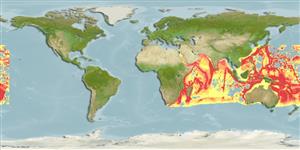分類 / Names
共通名の | 類義語 | Catalog of Fishes(部類, 種) | ITIS | CoL | WoRMS | Cloffa
Environment: milieu / climate zone / depth range / distribution range
生態学
海 底生の漂泳性; 深さの範囲 0 - 4960 m (Ref. 40919). Deep-water; 32°N - 35°S, 18°E - 169°W
Indo-Pacific: Red Sea to Samoa and Ellice Islands, north to Japan, south to Lord Howe Island; Mariana Islands in Micronesia. Southeast Atlantic: False Bay, South Africa (Ref. 4404).
サイズ / 重さ / 年齢
Maturity: Lm ? range ? - ? cm
Max length : 30.0 cm SL オス/雌雄の選別がない; (Ref. 1602)
背面の脊椎 (合計): 11; 背鰭 (合計): 99-104; 肛門の骨 2; 臀鰭: 97 - 104
Adults inhabit deep waters but rises to the surface at night. Rare species (Ref. 559). They live in tubes in fine sand or mud and rise to the surface at night where they fall prey to pelagic fishes (Ref. 37816). Oviparous. Eggs are demersal and adhesive (Ref. 205), and are attached to the substrate via a filamentous, adhesive pad or pedestal (Ref. 94114). Larvae are planktonic, often found in shallow, coastal waters (Ref. 94114).
Life cycle and mating behavior
成熟 | 繁殖 | 放精 | 卵 | 生産力 | 幼生
Oviparous, distinct pairing (Ref. 205).
Myers, R.F., 1991. Micronesian reef fishes. Second Ed. Coral Graphics, Barrigada, Guam. 298 p. (Ref. 1602)
Human uses
より多くの情報
参考文献水産養殖水産養殖の紹介緊張遺伝子のElectrophoreses遺伝病気行列NutrientsMass conversion
協力者画像Stamps, Coins Misc.音シガテラ(食中毒の名前)速度泳ぐ 型式カマOtoliths脳視覚
用具
特記事項
XMLをダウンロードして下さい
インターネットの情報源
Estimates based on models
Preferred temperature (Ref.
123201): 2.4 - 6.8, mean 3.5 °C (based on 2061 cells).
Phylogenetic diversity index (Ref.
82804): PD
50 = 0.7500 [Uniqueness, from 0.5 = low to 2.0 = high].
Bayesian length-weight: a=0.00102 (0.00046 - 0.00225), b=3.06 (2.88 - 3.24), in cm total length, based on all LWR estimates for this body shape (Ref.
93245).
栄養段階 (Ref.
69278): 4.2 ±0.73 se; based on food items.
回復力 (Ref.
120179): 手段, 1.4年~4.4年の倍増期間の最小個体群 (Assuming tm=1-4 and Fec=100-1000).
Fishing Vulnerability (Ref.
59153): Low to moderate vulnerability (27 of 100).
